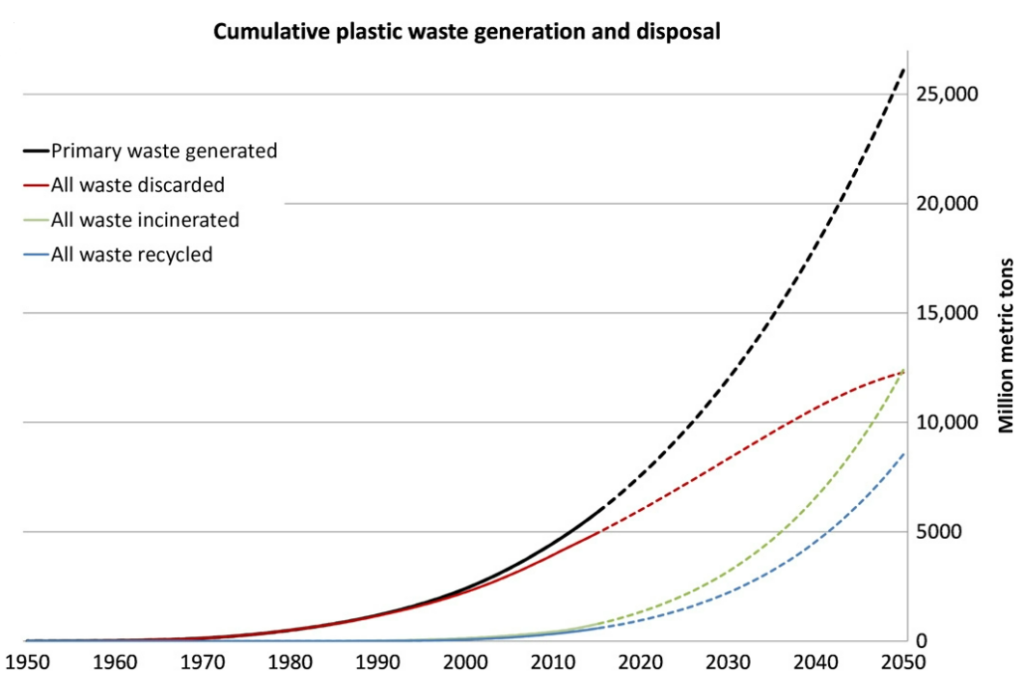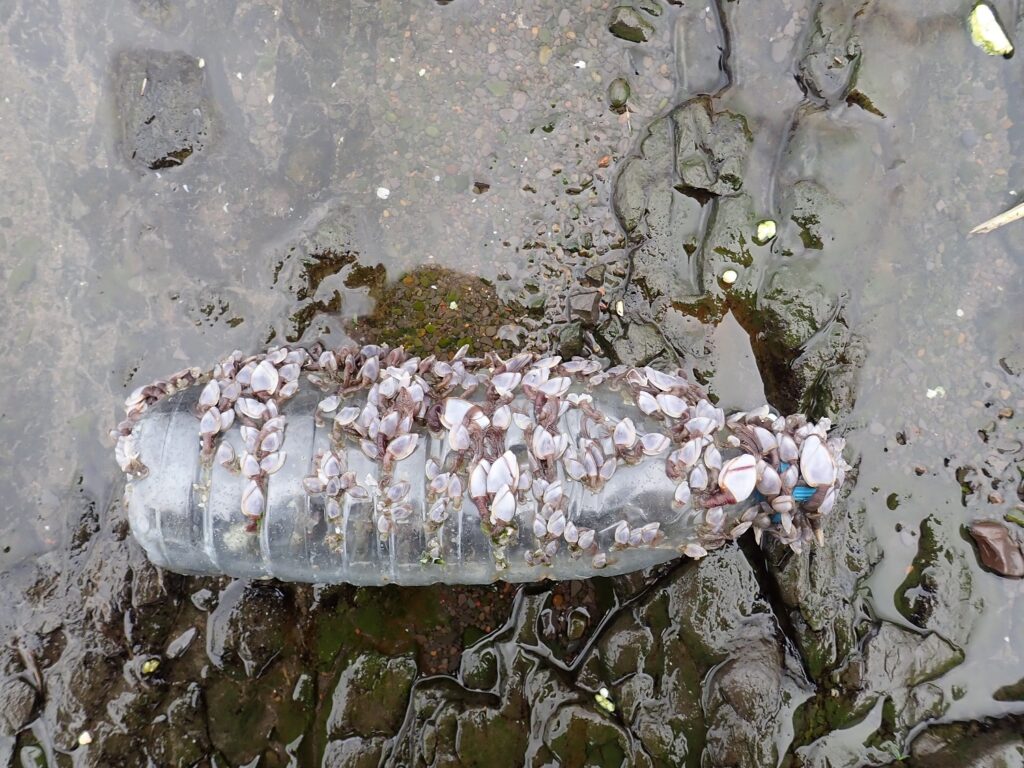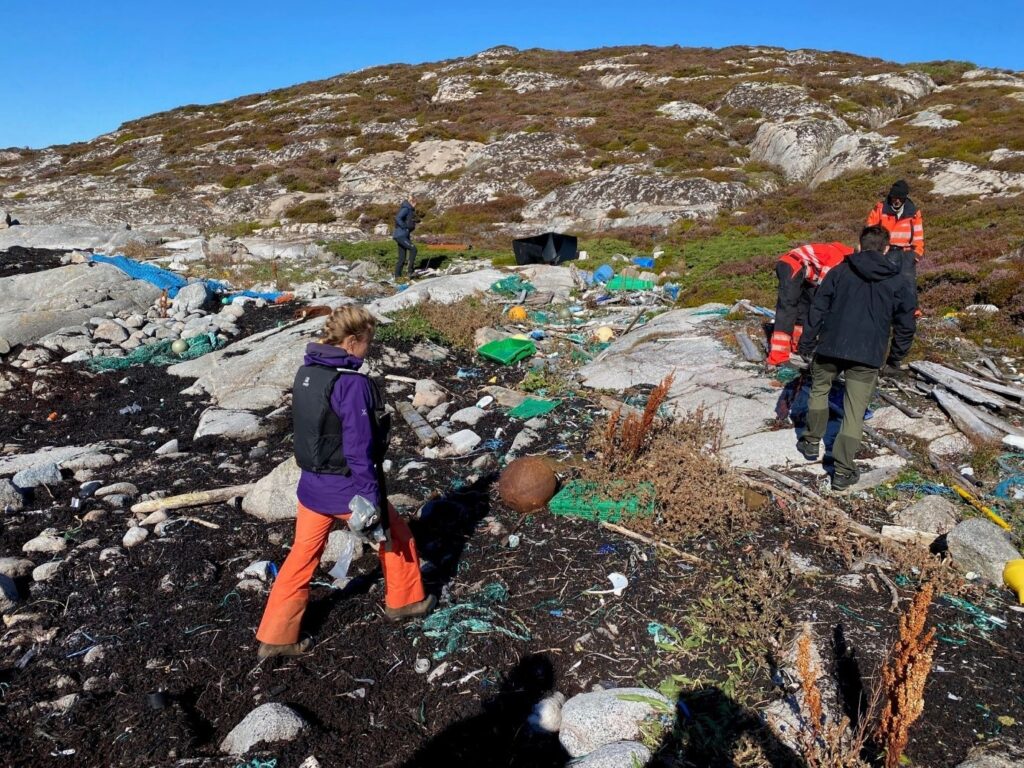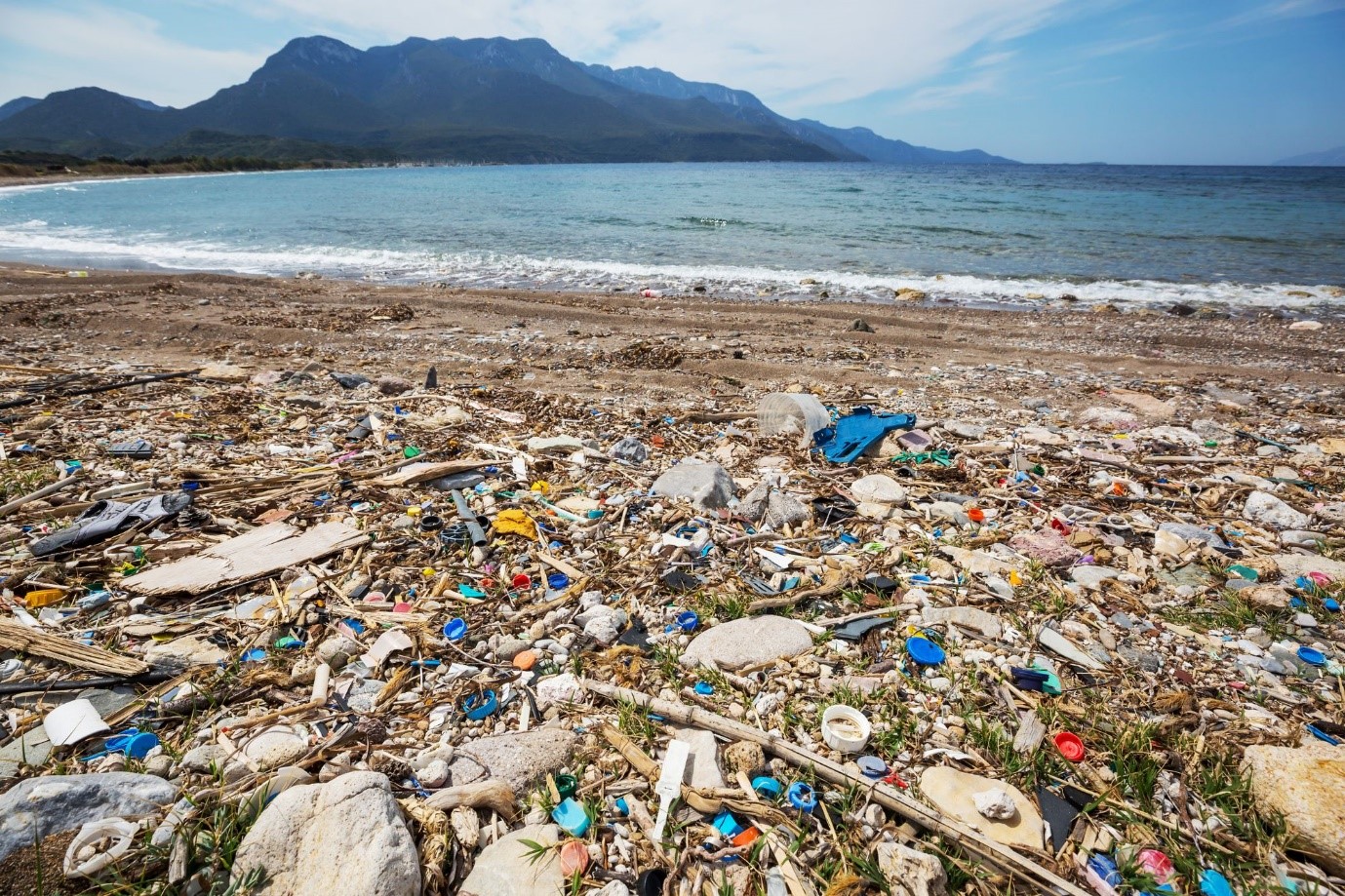A polymer is a material that consists of many repeated smaller subunits known as monomers. The way these monomers are arranged results in the formation of different kinds of polymers with distinctive physical and chemical properties. Polymers can be naturally occurring (e.g., silk, natural rubber, wool) or man-made (e.g., thermoplastics, synthetic rubber, silicone). The term “plastic” is used to refer to synthetic (man-made) polymers that are made from nonrenewable organic petrochemicals (e.g., oil and gas) [2]. At the moment, thousands of different plastic polymers each with unique chemical properties are being commercially produced [2,3].
Different product applications require different chemical and physical properties. Polyethylene terephthalate (PET) and high-density polyethylene (HDPE) for example are commonly used in plastic bottles. Polyvinyl chloride (PVC) on the other hand is strong, lightweight, dense, and resistant to many chemicals, and therefore is used in the manufacturing of pipes. Moreover, each of the different plastic polymers contains different additives and processing aids to enhance performance, many of which are classified as hazardous [4–10], but are understudied, or inadequately regulated [2].
Incredibly versatile
We have benefitted substantially from plastics [11]. For example, it is used in the packaging of food items to make them last longer. Due to its lightweight, plastic also requires less energy when it comes to the transportation of packaged goods. Packaged goods need less plastic material as compared to e.g., glass, since plastic has a high strength-to-weight ratio. With plastic being incredibly versatile, it is used extensively in a wide range of industrial applications and products. Since ~1950 plastic production has increased by 230-fold [12], becoming one of the largest man-made materials. With this rapid growth in its production, plastic waste has also been surging since ~1950 (see the figure below), and future trends are not showing any slowdown [13].

Unfortunately, plastic products are often being mismanaged once they reach their end of life and eventually find their way to the natural environment. In 2015 alone, 4.8-12.7 million metric tons of plastics were released to the ocean only from land-based human activities [14]. Once plastics reach the environment, they degrade very slowly since they are derived from hydrocarbons [15], leading to an accumulation of plastics in the environmental compartments, and especially in the ocean since it is the last and biggest sink for plastic waste. This has resulted in the formation of marine debris hotspots in the global oceans [16,17], and due to the continuous ocean circulation, plastic items can easily be transported over vast distances due to their lightweight and buoyancy [18], making it a global issue.
Impacts on marine species

The presence of plastic in the ocean has tremendous impacts on the marine ecosystems. It can alter the marine carbon cycle and affect the ability of the ocean to sequester carbon out of the atmosphere, which can eventually accelerate climate change and ocean acidification. An estimated 7.8 million metric tons of plastic carbon reach the seafloor every year[19]. Furthermore, marine biodiversity is increasingly at risk due to plastic pollution. Marine species can get entangled with plastic items where their movement becomes hindered, or mistake plastic items for food, which gives them a false feeling of satiation, leading to mortality. Over 350 different species have been observed entangled with plastic debris[20]. The uptake of plastics by marine organisms could potentially cause the bioaccumulation of plastics and chemical additives, posing a potential risk even to humans through the food web. Plastic fractions have already been found in human foods [21–23], human vein tissue [24], and stool [25].
Plastic items in the ocean can also act as a medium for the transport of invasive alien species, which eventually leads to species being introduced to new ecosystems where they can outcompete the native species, and hence cause a decline in the species richness within the ecosystem.

Efficiency aiming at reducing environmental impacts must not backfire
With this ever-growing trend of plastic waste generation and mismanagement, plastic pollution is expected to increase, posing a serious threat to ecosystems and, potentially, humans. We clearly need to find solutions to address the issue of plastic pollution. Current policies are increasingly emphasizing on achieving increased circularity and recycling of plastic waste. These policies will undoubtedly help in preserving our fossil reserves, but they will certainly not prevent plastics from leaking to the environment. These policies could even potentially lead to increased plastic pollution mainly due to a phenomenon known as “Jevon’s Paradox”[28,29]. Jevon’s Paradox states that increased efficiency (in the form of technological improvement) aiming at reducing the environmental impacts in most cases backfire. Take airplanes as an example; as they became more fuel efficient, ticket prices became cheaper, resulting in more people flying and hence led to an increase in the overall environmental impact.
In fact, we have already experienced some form of Jevon’s Paradox with plastics throughout their development. The increase in our consumption since ~1950 is a result of plastic production becoming more efficient and cheaper. A higher recycling rate will lead to a further drop in the price of plastics and may even give the consumers the perception that their consumption has no negative environmental impacts, since their plastic waste will be “managed” in an environmentally sustainable way.
However, even when looking at plastics within the circular economy concept, achieving full circularity is not an easy task. For instance, plastic polymers lose their quality and strength as they get recycled[30], and not all plastic polymers are easy to recycle (e.g., polystyrene) or recyclable (e.g., polyvinyl chloride). The physical and chemical contamination of plastics[31] is another barrier that hinders our ability to create a full-blown circular system.
Coastline case: Frøya in Norway

Even in well developed countries with highly efficient waste management systems and high collection rates, plastic items are often found in the environment. In Norway, which is considered an affluent country, a significant share of the plastic items found at the Norwegian coasts are of a Norwegian origin, while the rest come from countries that are also highly developed, such as the United Kingdom, Denmark, and Germany to name a few [32]. The picture above shows the extent of plastic pollution found in a nature reserve island located at the outer Norwegian coastline. Accepting the fact that plastic pollution is only a problem of the developing world is an obviously flawed assumption.

The solutions we need
The solutions we need rely on a whole systemic and structural change within the plastic system. Beach clean-ups are certainly important, but unfortunately, they are only addressing the symptoms of the plastic pollution issue.
We need a set of solutions: We need to prevent plastics from entering the environment in the first place. We need to design products that contain less plastics and ones that last longer. We need to find alternative materials that can replace plastics. We need to monitor the chemicals and additives added to the plastics, and we most importantly need to reduce our consumption. We need policies that aim at reflecting the environmental impacts of plastic products in their prices.
If humanity continues with the existing system aiming at increased growth without respecting the biophysical boundaries of the planet, our oceans will soon be full of plastics, outnumbering all the fish, and we will soon exploit all of the fossil reserves, polluting the atmosphere and causing irreversible ecological changes, and as Herman Daly said: “As the world becomes full of us and our stuff, it becomes empty of what was here before” [33].
About

This blog article is in part inspired by and based on the research plan of Ahmed Marhoon for his PhD thesis within the MAPLE project. Ahmed Marhoon is a PhD Candidate at NTNU – Department of Energy and Process Engineering and the Industrial Ecology Programme.
References
[1] Hosler, D.; Burkett, S.L.; Tarkanian, M.J. Prehistoric Polymers: Rubber Processing in Ancient Mesoamerica. Science 1999, 284(5422), 1988–1991.
[2] Wiesinger, H.; Wang, Z.; Hellweg, S. Deep Dive into Plastic Monomers, Additives, and Processing Aids. Environ. Sci. Technol. 2021, 55(13), 9339–9351.
[3] Rosato, D.V.; Di Mattia, D.P.; Rosato, D.V. Designing with Plastics and Composites: A Handbook. Springer US: Boston, MA, 1991.
[4] Lithner, D.; Damberg, J.; Dave, G.; Larsson, Å. Leachates from plastic consumer products – Screening for toxicity with Daphnia magna. Chemosphere 2009, 74(9), 1195–1200.
[5] Lithner, D.; Nordensvan, I.; Dave, G. Comparative acute toxicity of leachates from plastic products made of polypropylene, polyethylene, PVC, acrylonitrile–butadiene–styrene, and epoxy to Daphnia magna. Environ. Sci. Pollut. Res. 2012, 19(5), 1763–1772.
[6] Bejgarn, S.; MacLeod, M.; Bogdal, C.; Breitholtz, M. Toxicity of leachate from weathering plastics: An exploratory screening study with Nitocra spinipes. Chemosphere 2015, 132, 114–119.
[7] Hamlin, H.J.; Marciano, K.; Downs, C.A. Migration of nonylphenol from food-grade plastic is toxic to the coral reef fish species Pseudochromis fridmani. Chemosphere 2015, 139, 223–228.
[8] Gandara e Silva, P.P.; Nobre, C.R.; Resaffe, P.; Pereira, C.D.S.; Gusmão, F. Leachate from microplastics impairs larval development in brown mussels. Water Res. 2016, 106, 364–370.
[9] Li, H.-X.; Getzinger, G.J.; Ferguson, P.L.; Orihuela, B.; Zhu, M.; Rittschof, D. Effects of Toxic Leachate from Commercial Plastics on Larval Survival and Settlement of the Barnacle Amphibalanus amphitrite. Environ. Sci. Technol. 2016, 50(2), 924–931.
[10] Zimmermann, L.; Dierkes, G.; Ternes, T.A.; Völker, C.; Wagner, M. Benchmarking the in Vitro Toxicity and Chemical Composition of Plastic Consumer Products. Environ. Sci. Technol. 2019, 53(19), 11467–11477.
[11] Andrady, A.L.; Neal, M.A. Applications and societal benefits of plastics. Philos. Trans. R. Soc. B Biol. Sci. 2009, 364(1526), 1977–1984.
[12] OECD. Global Plastics Outlook: Economic Drivers, Environmental Impacts and Policy Options. Organisation for Economic Co-operation and Development: Paris, 2022.
[13] Geyer, R.; Jambeck, J.R.; Law, K.L. Production, use, and fate of all plastics ever made. Sci. Adv. 2017, 3(7), e1700782.
[14] Jambeck, J.R.; Geyer, R.; Wilcox, C.; Siegler, T.R.; Perryman, M.; Andrady, A.; Narayan, R.; Law, K.L. Plastic waste inputs from land into the ocean. Science 2015, 347(6223), 768–771.
[15] Chamas, A.; Moon, H.; Zheng, J.; Qiu, Y.; Tabassum, T.; Jang, J.H.; Abu-Omar, M.; Scott, S.L.; Suh, S. Degradation Rates of Plastics in the Environment. ACS Sustain. Chem. Eng. 2020, 8(9), 3494–3511.
[16] Eriksen, M.; Lebreton, L.C.M.; Carson, H.S.; Thiel, M.; Moore, C.J.; Borerro, J.C.; Galgani, F.; Ryan, P.G.; Reisser, J. Plastic Pollution in the World’s Oceans: More than 5 Trillion Plastic Pieces Weighing over 250,000 Tons Afloat at Sea. PLOS ONE 2014, 9(12), e111913.
[17] Lebreton, L.; Slat, B.; Ferrari, F.; Sainte-Rose, B.; Aitken, J.; Marthouse, R.; Hajbane, S.; Cunsolo, S.; Schwarz, A.; Levivier, A.; Noble, K.; Debeljak, P.; Maral, H.; Schoeneich-Argent, R.; Brambini, R.; Reisser, J. Evidence that the Great Pacific Garbage Patch is rapidly accumulating plastic. Sci. Rep. 2018, 8(1), 4666.
[18] Law, K.L. Plastics in the Marine Environment. Annu. Rev. Mar. Sci. 2017, 9(1), 205–229.
[19] Smeaton, C. Augmentation of global marine sedimentary carbon storage in the age of plastic. Limnol. Oceanogr. Lett. 2021, 6(3), 113–118.
[20] Kühn, S.; Franeker, J.A. van. Quantitative overview of marine debris ingested by marine megafauna. Mar. Pollut. Bull. 2020, 151, 110858.
[21] Liebezeit, G.; Liebezeit, E. Non-pollen particulates in honey and sugar. Food Addit. Contam. Part A 2013, 30(12), 2136–2140.
[22] Liebezeit, G.; Liebezeit, E. Synthetic particles as contaminants in German beers. Food Addit. Contam. Part A 2014, 31(9), 1574–1578.
[23] Yang, D.; Shi, H.; Li, L.; Li, J.; Jabeen, K.; Kolandhasamy, P. Microplastic Pollution in Table Salts from China. Environ. Sci. Technol. 2015, 49(22), 13622–13627.
[24] Rotchell, J.M.; Jenner, L.C.; Chapman, E.; Bennett, R.T.; Bolanle, I.O.; Loubani, M.; Sadofsky, L.; Palmer, T.M. Detection of microplastics in human saphenous vein tissue using μFTIR: A pilot study. PLOS ONE 2023, 18(2), e0280594.
[25] Schwabl, P.; Köppel, S.; Königshofer, P.; Bucsics, T.; Trauner, M.; Reiberger, T.; Liebmann, B. Detection of Various Microplastics in Human Stool. Ann. Intern. Med. 2019, 171(7), 453–457.
[26] Marine Debris Program. Plastics in the Ocean: How They Get There, Their Impacts, and Our Solutions. https://blog.marinedebris.noaa.gov/plastics-ocean-how-they-get-there-their-impacts-and-our-solutions (accessed Mar. 2023).
[27] Douillet, G.A. Plastic “sediments”, driver of invasive species? (Anthropocene in Taiwan). https://imaggeo.egu.eu/view/12321/ (accessed Mar. 2023).
[28] Alcott, B. Jevons’ paradox. Ecol. Econ. 2005, 54(1), 9–21.
[29] Sorrell, S. Jevons’ Paradox revisited: The evidence for backfire from improved energy efficiency. Energy Policy 2009, 37(4), 1456–1469.
[30] Eriksen, M.K.; Damgaard, A.; Boldrin, A.; Astrup, T.F. Quality Assessment and Circularity Potential of Recovery Systems for Household Plastic Waste. J. Ind. Ecol. 2019, 23(1), 156–168.
[31] Eriksen, M.K.; Pivnenko, K.; Olsson, M.E.; Astrup, T.F. Contamination in plastic recycling: Influence of metals on the quality of reprocessed plastic. Waste Manag. 2018, 79, 595–606.
[32] Haar, M.L.; Höjman, C.; Solbakken, V.S.; Pires, R.; Martinussen, K.; Falk-Andersson, J.; Cyvin, J.B. Marin forsøpling i norske fylker. 2022.
[33] Daly, H.E. Economics in a full world. Sci. Am. 2005.


